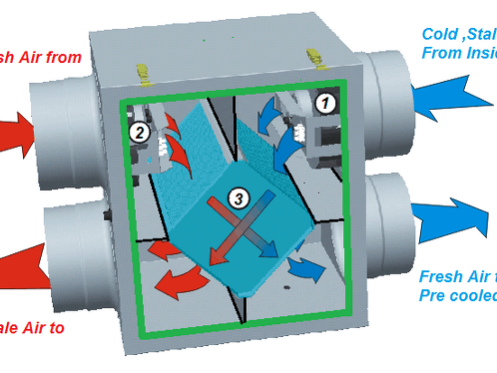During the summer, lowering indoor humidity is an admirable goal. And that’s especially true if you live in Georgia or anywhere in the sultry Southeast.
Maintaining relative humidity below 50% in your home keeps you comfortable without lowering the temperature on your thermostat. It also improves indoor air quality and helps you avoid potentially expensive problems, like mold growth inside your home.
Anyway, a lot of people ask us about energy recovery ventilators (ERVs) and whether they’re a good choice for introducing fresh air to the home while lowering indoor humidity. The answer is no. Installing an ERV is a great way to ventilate your home, but it’s a poor choice for dehumidifying indoor air.
That’s right: An ERV will not help you dehumidify your home. Since you might have heard otherwise, let’s take a closer look at ERVs, whole-house dehumidifiers, and the best options for our climate zone.
Controlled ventilation is a beautiful thing
For all of our talk about air sealing your home and tightening the building envelope, you might be surprised to learn that we’re also big fans of ventilation (no pun intended).
That’s because consistent ventilation helps you:
- Circulate healthy fresh air
- Dilute or remove airborne contaminants
Kill nasty odors that develop inside your living space
The catch is that we only like controlled ventilation. And by “controlled,” we’re not talking about opening a window. We’re talking about ventilation techniques that introduce fresh air from the outdoors, filter it, and circulate it inside your home before removing it and beginning the process again.
Opening a window ventilates the home, but it doesn’t filter the air that comes in. The same goes for air leaks in your attic and crawl space. They help circulate air, but they don’t do anything to ensure the air is healthy and safe to breathe.
In a properly air-sealed home with a tight envelope, the best way to achieve controlled ventilation is with an ERV, HRV (heat recovery ventilator), or ventilating dehumidifier.
In Georgia, an ERV makes more sense than an HRV
Maybe you’re an Atlanta-area homeowner using a variable speed air conditioner, or you don’t have a problem keeping relative humidity below 50% during the summer. If you just need a way to ventilate your home, an ERV is a fine choice.
Why an ERV and not an HRV? Because an HRV doesn’t do anything to reduce the amount of humidity entering your home:
- Both ERVs and HRVs transfer heat between the air entering and leaving your home.
- Only ERVs transfer moisture between the air entering and leaving your home.
So, if the relative humidity outdoors is 90%, an HRV brings that humid air straight into your air conditioning system. An ERV, on the other hand, removes some of that moisture from the air before bringing it into your home.
That’s why many people believe that an ERV dehumidifies indoor air. When the ERV transfers moisture from the incoming air to the outgoing air, the amount of moisture entering the home is lower than it would be with an HRV.
But reducing moisture isn’t the same thing as dehumidification.
ERVs ventilate, but they don’t dehumidify
Now let’s consider an Atlanta homeowner with a humidity problem. Even when she sets her thermostat to 75 degrees, relative humidity hovers between 55% and 60%. Will an ERV help her dehumidify her home without lowering the thermostat?
Probably not. It could make the problem worse.
When outdoor air is more humid than indoor air, it’s unlikely that an ERV will remove enough moisture from the incoming airstream to reduce relative humidity inside the home. If the ERV is pulling in the air at 90% relative humidity, even a 20% reduction would still be pretty humid. The homeowner would have to keep lowering the temperature on her thermostat to dehumidify the air and stay comfortable.
Using an ERV during the summer ensures that you will maintain humidity levels inside your home or increase them. It makes more sense than an HRV, but it’s still not great.
The solution? Whole house dehumidifier + fresh, outdoor air
In our climate zone, the best equipment for ventilating your home and dehumidifying indoor air is a whole house dehumidifier with positive pressure from fresh, outdoor air.
Like an ERV, a ventilating dehumidifier introduces fresh air from outside your home, filters it, and removes indoor air for consistent circulation. The big difference is that it also dehumidifies the air before bringing it into your living space, resulting in:
- Clean, dry air that’s constantly cycled in and out of your home
- Fewer lingering airborne contaminants
- Fewer dust mites and better conditions for occupants with allergies
- Zero opportunities for mold growth
Could you install an ERV instead? Sure, and many people do. But if you’re trying to dehumidify the air, you’ll have to lower the temperature on your thermostat and run your air conditioner for longer cycles. The ERV isn’t going to help.
Compared to an ERV, a whole house dehumidifier and fresh air system is, by far, the more efficient, effective choice for Atlanta-area homes.

